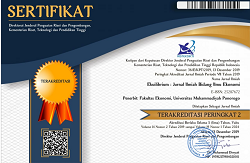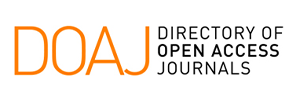Econometrics Model of Economic Growth in East Java Province with Dynamic Panel Data through Generalized Method of Moment (GMM) Approach
DOI: 10.24269/ekuilibrium.v15i1.2020.pp38-54
Abstract
Increasing the rate of economic growth is one of the biggest goals for an area, because it affects macroeconomic conditions in the aggregate especially the level of public welfare. Law Number 32 of 2004 becomes empirical evidence that there is a transfer of responsibility from the central government to regional governments in carrying out economic development. This research is conducted to determine the condition of economic growth in East Java Province with a population of 29 districts and 9 cities in the 2014-2018 observation period, the number of samples was 190 samples. The data analysis technique is carried out through the econometrics model with two stages, namely conducting a simultaneous regression analysis of the ordinary least square method, then for the second stage, an Arellano-Bond Generalized Method of Moment (GMM) analysis is carried out on the grounds that many economic variables are dynamic, This means that the value of a variable can be influenced by the value of other variables and is influenced by the value of the variable concerned in the past or previous period,in addition to knowing the short-term and long-term effects of economic growth. The findings of the study reveal that simultaneous economic growth in East Java Province is influenced by agglomeration, fiscal decentralization, poverty rates and human development index. Based on the results of the generalized method of moment arellano-bond analysis, the researchers find that fiscal decentralization have a partial effect on economic growth in the province of East Java with the impact of the elasticity of short-term and long-term economic growth values. In addition, researchers find that economic growth in East Java Province is influenced by the value of the variable itself (economic growth) in the previous period.
Keywords
Economic growth, Agglomeration, Fiscal Decentralization, Poverty level, Human Development Index
References
- Adisasmita, Rahardjo, 2014, Pertumbuhan Wilayah dan Wilayah Pertumbuhan, Penebit Graha Ilmu, Yogyakarta.
- Anita, et al., 2014, “Pengaruh Desentralisasi Fiskal terhadap Pertumbuhan Ekonomi di Provinsi Aceh”, Jurnal Ilmu Ekonomi Pascasarjana Universitas Syiah Kuala, 2(3), 21-29
- Asmawan, M Sulis Andre & Hariyanto, Bambang, 2017, “Kajian Aglomerasi Industri Logam di Desa Ngingas Kecamatan Waru Kabupaten Sidoarjo”, Jurnal Swara Bhumi, 5(2), 41-47
- Babiarz, et al., 2018, “The Application of Customized Human Development Index to the Analysis of Socioeconomic Development of the European Union Member States”, Interdisciplinary Approach to Economics And Sociology, 11(4), 332-342
- Badan Pusat Statistik, 2020, Retrieved from https://www.bps.go.id/.
- Bashir, Abdul., 2011, “Dampak Desentralisasi Fiskal terhadap Perekonomian Daerah Kabupaten/Kota Di Provinsi Sumatera Selatan”, Jurnal Kajian Ekonomi, 10(2), 1-32
- Biyase, Mduduzi & Rooderick, 2017, “Determinants of Growth in SADC Countries: A Fixed Effect Vector Decomposition Approach”, International Journal of Economics and Financial Issues, 7(4), 746-751
- Chaudhry, Rehan, 2014, “Fiscal Decentralization, Natural Disasters, and Economic Growth”, UMI Dissertation Publishing, Published by ProQuest, UMI 1525275
- Chen, Ke-Mei & Wang, Te-Mu, 2015, “Determinants of Poverty Status in Taiwan: A Multilevel Approach”, Springer Science+Business Media Dordrecht, 123, 371–389. DOI 10.1007/s11205-014-0741-4.
- Dewi, et al., 2017, “Pengaruh Kemiskinan dan Pertumbuhan Ekonomi terhadap Indeks Pembangunan Manusia di Provinsi Riau”. JOM Fekon. 4(1), 870-882.
- Dewi, Nyoman Lilya Santika & Sutrisna, I Ketut, 2014, “Pengaruh Komponen Indeks Pembangunan Manusia terhadap Pertumbuhan Ekonomi Provinsi Bali”, E-Jurnal Ekonomi Pembangunan Universitas Udayana, 3(3), 106 – 114.
- Dariwardani, 2014, “Analisis Dinamika Kemiskinan (Poverty Dynamics) di Bali Berdasarkan Data Susenas Panel 2008-2010”, Jurnal Ekonomi Kuantitatif Terapan, 7(1), 7-15.
- Erwin, et al., 2013, “Analisis Faktor-Faktor yang Mempengaruhi Tingkat Kesejahteraan Masyarakat Kabuaten/Kota di Provinsi Bali”, Fakultas Ekonomi dan Bisnis Universitas Udayana (Unud), Bali, Indonesia
- Faisal, Ade, 2019, “Analisis Kebijakan Pembangunan Industri Berbasis Aglomerasi (Kawasan) Industri”, Bappenas Working Papers, 2(2), 248-269
- Fajar, M & Azhar, Zul, 2018, “Indeks Persepsi Korupsi dan Pembangunan Manusia terhadap Pertumbuhan Ekonomi di Negara-Negara Asia Tenggara”, Jurnal EcoGen, 1(3), 681-690
- Ghazo, et al., 2017, “Causalities among Human Capital, Investment, Openness, and Economic Growth: an Empirical Investigation for Jordan”, International Journal of Economic Perspectives, 11(4), 162-174.
- Habibah, Tutut Umul & Hariyanto, Bambang, 2018, “Kajian Aglomerasi Industri Kerajinan Mebel di Desa Wringinpitu Kecamatan Mojowarno Kabupaten Jombang”, Fakultas Ilmu Sosial dan Hukum Universitas Negeri Surabaya, 5(9), Retrieved from https://jurnalmahasiswa.unesa.ac.id/index.php/swara-bhumi/article/view/26733.
- Hasanah, Fatihatun & Mustofa, 2016, “Analisis Pengaruh Aglomerasi Industri, Angkatan Kerja dan Human Capital Investment terhadap Pertumbuhan Ekonomi Kabupaten/Kota di Provinsi Jawa Tengah Tahun 2012-2014”, Jurnal Pendidikan dan Ekonomi, 5(4), 283-291
- He, Q & Sun, M., 2014, “Does Fiscal Decentralization Promote the Inflow of FDI in China”, Economic Modelling, 43, 361–371
- Izzah, N., 2015, “Analisis Pengaruh Indeks Pembangunan Manusia (IPM) dan Inflasi terhadap Pertumbuhan Ekonomi di Propinsi Riau Tahun 1994-2013”, Jurnal At-Tijaroh, 1(2), 156-172
- Jafar, Juandi, 2017, “Pengaruh Kemiskinan terhadap Pertumbuhan Ekonomi melalui Pengangguran di Kabupaten Bone”, Universitas Negeri Makassar, Retrieved from http://eprints.unm.ac.id/8657/.
- Jia, et al., 2014, “Fiscal Decentralization and Local Expenditure Policy in China”, China Econ. Rev. 28, 107–122.
- Kis-Katos, K., &Sjahrir, B. S., 2017, “The Impact of Fiscal and Political Decentralization on Local Public Investment in Indonesia” Journal of Comparative Economics, 45(2), 344-365.
- Khusaini, Muhammad, 2013, EkonomiMikro: Dasar-DasarTeori, UB Press, Malang.
- Lengkong, et al., 2017, “Pengaruh Alokasi Anggaran Pendidikan dan Kesehatan terhadap Indeks Pembangunan Manusia dan Dampaknya terhadap Pertumbuhan Ekonomi Kota Bitung”, Jurnal Pembangunan Ekonomi dan Keuangan Daerah, 19(2), 1-20.
- Malicka, et al., 2017, “Relationship between Fiscal Decentralization and Economic Growth in European Union Countries and Slovakia”, Ekonomicky Casopis, 65(9), 856 – 875.
- Mankiw, N.G., Quah, E. and Wilson, P., 2013, “Pengantar Ekonomi Makro, Pengantar Ekonomi Makro”, Retrieved from https://doi.org/10.3390/bs30100.
- Marhaeni, et al., 2014, “Evaluasi Program-Program Pengentasan Kemiskinan di Provinsi Bali”, Jurnal PIRAMIDA, 10(1), 8-18.
- Mauleny, Ariesy Tri, 2015, Aglomerasi, Perubahan Sosial Ekonomi, dan Kebijakan Pembangunan Jakarta”, Jurnal Ekonomi & Kebijakan Publik, 6(2), 147 – 162.
- Miri, et al., 2017, “Fiscal Decentralization and Economic Growth in Morocco: A Panel Cointegration Analysis”, International Journal of Economics and Financial Issues, 7(6), 192-201.
- Mirza, Denni Sulistio, 2011, “Pengaruh Kemiskinan, Pertumbuhan Ekonnomi dan Belanja Modal terhadap IPM Jawa Tengah”, JEJAK, 4(2).
- Mubaroq, et al., 2013, “The Effect of the Government Investment, Employment, and Fiscal Decentralization on Economic Growth of Regencies in Indonesia 2007-2010”, Retrieved from http://pustaka.unpad.ac.id/wp-content/uploads/2013/01/Jurnal-M-Rizal-M-MET-UNPAD.pdf.
- Mukhlis, M. K., et al., 2019, “Potensi Aglomerasi Industri Kecil dan Pertumbuhan Ekonomi di Provinsi Sumatera Selatan”, Doctoral Dissertation, Sriwijaya University.
- Muqorrobin, Moh & Soejoto, Ady, 2017, “Pengaruh Indeks Pembangunan Manusia (IPM) terhadap Pertumbuhan Ekonomi di Jawa Timur”, Jurnal Pendidikan Ekonomi, 5(3), Retrieved from https://jurnalmahasiswa.unesa.ac.id/index.php/jupe/article/view/20602.
- Nair, Manju S., 2018, “Human Development and Economic Growth in Kerala: Sustainability Issues”, Productivity, 59(1), 81-91.
- Noviatamara, et al., 2019, “Analisis Pengaruh Pertumbuhan Ekonomi dan Tingkat Pengangguran Terbuka di Daerah Istimewa Yogyakarta”, Jurnal REP (Riset Ekonomi Pembangunan), 4(1), 53-60.
- Novriansyah, Moh. Arif, 2018, “Pengaruh Pengangguran dan Kemiskinan terhadap Pertumbuhan Ekonomi di Provinsi Gorontalo”, Gorontalo Development Review, 1(1), 59-73.
- Nyasha, et al., 2017, “Poverty and Economic Growth in Ethiopia: a Multivariate Causal Linkage”, The Journal of Developing Areas, 51(1), 344-359.
- Panggabean, Meiran, 2014, “The Influence of Private Investment, Human Development Index (HDI) and Local Government Capital Expenditure (LGCE) on the Economic Growth and Original Local Government Revenue (OLGR) in the Regency/City of West Kalimantan Province”, International Journal of African and Asian Studies - An Open Access International Journal, 4, 142-150.
- Parhah, S., 2018, “Kontribusi Desentralisasi Fiskal terhadap Pertumbuhan Ekonomi Indonesia (Analisis Data Cross-Section Tahun 2002)”, Retrieved from http://file.upi.edu/direktori/fpeb/prodi._ekonomi_dan_koperasi/siti_parhah/kontribusi_desentralisasi_fiskal_terhadap_pertumbuhan_ekonom.pdf.
- Pratama, AA Gede Krisna & Darsana, Ida Bagus, 2019, “Pengaruh Kemiskinan dan Investasi terhadap Pertumbuhan Ekonomi dan Kesejahteraan Masyarakat”, E-Jurnal EP Unud, 8(6), 1300-1330.
- Pratama, Nengah Rai Narka Suda & Utama, Made Suyana, 2019, “Pengaruh Pengeluaran Pemerintah dan Investasi terhadap Pertumbuhan Ekonomi dan Tingkat Kemiskinan di Kabupaten/Kota Provinsi Bali”, E-Jurnal Ekonomi dan Bisnis Universitas Udayana, 8(7), 651-680.
- Priyono, et al., 2019, “Studi Empiris: Peran Desentralisasi Fiskal Terhadap Peningkatan Kesejahteraan Masyarakat Dengan Pertumbuhan Ekonomi Sebagai Variabel Intervening Pada Kabupaten/Kota Di Indonesia”, Jurnal RAK (Riset Akuntansi Keuangan), 4(2), 13-25.
- Purnama, 2016, “Faktor-faktor yang mempengaruhi Kemiskinan di Provinsi Bali”, Jurnal PIRAMIDA, 12(1), 101–110.
- Rahman, Sanzidur, 2017, “Determinants of Poverty in the Urban Slums of Bangladesh”, Current Politics and Economics of South, 26(2), 168-182.
- Razaq, Abd & Christiawan, Putu Indra, 2019, “Analisis Faktor Aglomerasi Industri Manufaktur di Desa Celukanbawang Kecamatan Gerokgak Kabupaten Buleleng”, Jurnal Pendidikan Geografi Undiksha, 7(1), 8-17.
- Rosdyana, Dewi & Suhendra, E. Susy, 2015, “Pengaruh Desentralisasi Fiskal terhadap Pertumbuhan Ekonomi Daerah dan Ketimpangan Pendapatan di Pulau Jawa Tahun 2009-2013”, Prosiding Pesat (Psikologi, Ekonomi, Sastra, Arsitektur&Sipil), Universitas Gunadarma, 6, ISSN: 1858-2559.
- Sabilla, Kanetasya & Jaya, Wihana Kirana, 2014, “Pengaruh Desentralisasi Fiskal terhadap Pertumbuhan Ekonomi per Kapita Regional di Indonesia”, Jurnal Ekonomi dan Studi Pembangunan, 15(1), 12-22.
- Salim, et al., 2018, “Fiscal Desentralisation, Economics Growth and Human Development Index in Sumatera”, Jurnal Transformasi Administrasi, 8(2), 165-178
- Santoso, A. B. & Prabatmodjo, H, 2012, “Aglomerasi Industridan Perubahan Sosial Ekonomi di Kabupaten Bekasi”, Jurnal Perencanaan Wilayah dan Kota, SAPPK ITB, 1(2), 73-82.
- Sardiyo & Dhasman, Martini, 2019, “Globalization and Its Impact on Economic Growth: Evidence From Asean Countries”, Ekuilibrium: Jurnal Ilmiah Bidang Ilmu Ekonomi”, 14(2), 104-119.
- Sari, Cut Putri Mellita & Nurdin, Mhd, 2018, “Pengaruh Pertumbuhan Ekonomi, Pengeluaran Pemerintah di Sektor Pendidikan dan Kesehatan terhadap Kemiskinan di Provinsi Aceh”, Jurnal Ekonomika Indonesia, 7(1), 18-23.
- Sendouw, et al., 2017, “Pengaruh Belanja Modal, Belanja Sosial, dan Pertumbuhan Ekonomi terhadap Tingkat Kemiskinan di Kota Manado”, Jurnal Pembangunan Ekonomi dan Keuangan Daerah, 19(2), 1-15.
- Sukirno, Sadono, 2006, Ekonomi Pembangunan, Kencana, Jakarta.
- Sukirno, Sadono, 2011, Teori Pengantar Ekonomi Makro, Kencana, Jakarta.
- Sun, et al., 2016, “Fiscal decentralization and China’s Provincial Economic Growth: a Panel Data Analysis for China’s Tax Sharing System”, Springer Science+Business Media Dordrecht, 51, 2267–2289, DOI 10.1007/s11135-016-0386-2.
- Syaifullah, Ahmad & Malik, Nazaruddin, 2017, “Pengaruh Indeks Pembangunan Manusia dan Produk Domestik Bruto terhadap Tingkat Kemiskinan di ASEAN-4 (Studi pada 4 Negara Asean)”, Jurnal Ilmu Ekonomi, 1(1), 107 – 119.
- Tarigan, Robinson, 2004, Perencanaan Pembangunan Wilayah, PT Bumi Aksara, Jakarta.
- Todaro, Michael P & Stephen C. Smith, 2006, Pembangunan Ekonomi (Jilid I Edisi Kesembilan) Haris Munandar (Penerjemah)”, Penerbit Erlangga, Jakarta.
- Undang-undang Republik Indonesia Nomor 3 Tahun 2014 Tentang Perindustrian.
- Undang-undang Republik Indonesia Nomor 23 Tahun 2014 Tentang Pemerintah Daerah.
- Wetwitoo, Jetpan & Kato, Hironori, 2017, “Inter-regional transportation and economic productivity: a case study of regional agglomeration economies in Japan”, Springer-Verlag Berlin Heidelberg, 59, 321–344, DOI 10.1007/s00168-017-0833-6.
- Wibowo, Wisun A., 2013, “Pengaruh Faktor Aglomerasi Industri, Angkatan Kerja dan Tingkat Upah terhadap Pertumbuhan Ekonomi Kabupaten/Kota di Provinsi Jawa Tengah Tahun 2005-2010”, Artikel, Jurusan Ekonomi Pembangunan Fakultas Ekonomi Universitas Negeri Semarang.
- Winanto, Asis Riat, 2019, “Investment, Labor and Their Effects on Economic Growth of Ponorogo Regency”, Ekuilibrium: Jurnal Ilmiah Bidang Ilmu Ekonomi, 14(1), 58-73.
- Wulandari, et al., 2019, “Aglomerasi Industri Pengolahan di Wilayah Kabupaten Jember Tahun 2011-2015 (Studi Kasus: Subsektor Industri Makanan, Minuman, dan Tembakau)”, Journal Ekonomi Bisnis dan Akuntansi, 6(1), 76-80.
- Xiao-Ling, Y., Yu-Xian, F., & Jie, Q, 2013, A Positive Research on Spatial Agglomeration of China‟s Cultural Industries, Advances in Management & Applied Economics, 3(3), 245–257.
- Yacoub, Y, 2012, “Pengaruh Tingkat Pengangguran terhadap Tingkat Kemiskinan Kabupaten/Kota di Provinsi Kalimantan Barat”, Jurnal Ekonomi Sosial, Universitas Tanjungpura Pontianak.
- Yushkov, A., 2015, “Fiscal Decentralization And Regional Economic Growth: Theory, Empirics, And The Russian Experience”, Russian Journal of Economics, 1(4), 404-418.
Refbacks
- There are currently no refbacks.

This work is licensed under a Creative Commons Attribution-ShareAlike 4.0 International License.













